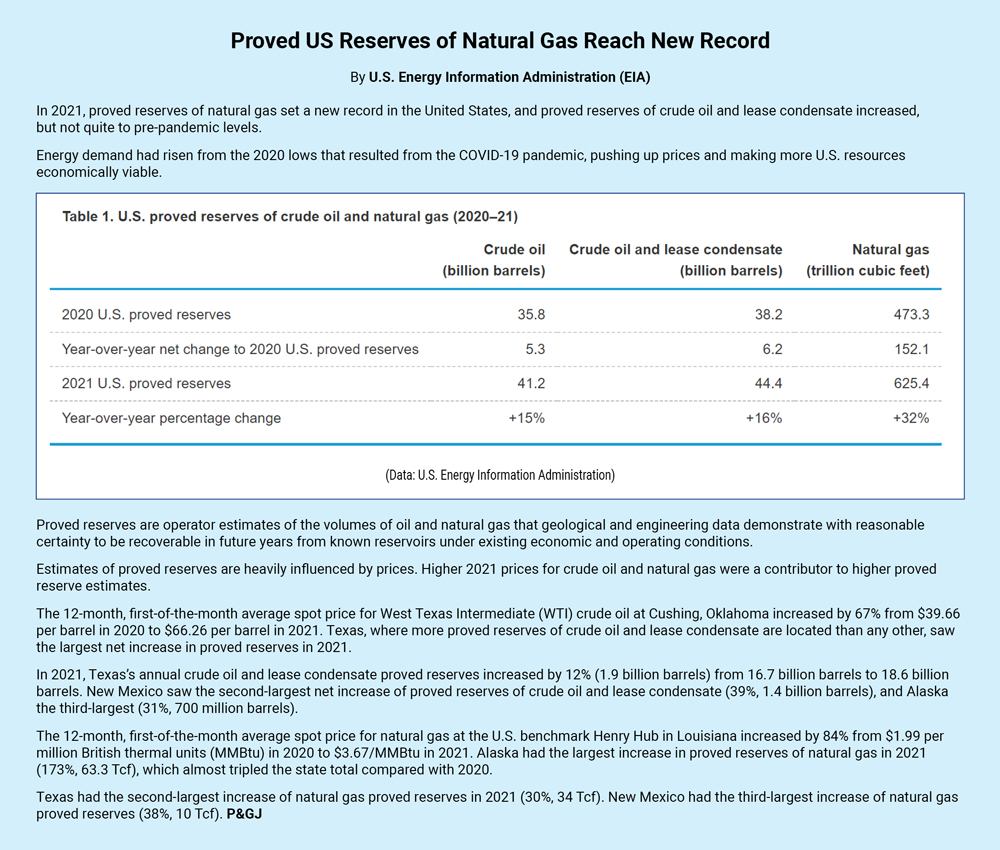March 2023, Vol. 250, No. 3
Features
Spire Adds Storage in Rockies, Western US
By Michael Reed, Editor-in-Chief
(P&GJ) — To meet the growing energy demands in the Rockies and Western U.S., Spire Storage is expanding its facilities in Wyoming, with partial availability of additional natural gas storage capacity becoming available in 2024.
Consistent with the Federal Energy Regulatory Commission (FERC) 7(c) project approval and FERC’s issuance of a Notice to Proceed, Spire Storage started limited construction of the initial project phase in mid-August. Full project completion is expected to take place over the next two years during construction seasons that run April through October in Wyoming.
The expansion project will increase Spire Storage underground working gas storage capacity from 23 Bcf to 39 Bcf, and involves the addition of injection and withdrawal wells, compression, pipeline infrastructure, and gas processing capability. Capital expenditures for the project are expected to total $195 million.
Scott Smith, who brought more than 30 years of energy industry experience to Spire Storage, when he became the company’s president in 2019, answered a few questions about this project and storage in general, during a recent interview with P&GJ.
P&GJ: In your view, how essential is natural gas storage when it comes to both energy security and as a means of supporting renewable power generation?
Scott Smith: Natural gas storage is an essential part of the gas delivery network to market participants that include electric and natural gas utilities. Storage is a key component that has been part of the natural gas delivery system sector in the United States for decades. And then to think about it from the standpoint of energy security includes security of supply when you have events like winter Storm Uri, which happened a couple of years ago.
Storage is essential in providing deliverability into the transmission system, whether that is incremental demand from colder than expected weather or variations to serve power generation, or alternatively, to cover production freezes as we have seen recently in certain parts of the country. So that element provides a substantial amount of reliability and security to those who consume natural gas.
From an energy security perspective, I think it’s a much broader question concerning the incremental deliverability and balancing storage can provide? Essentially the natural gas system in North America is built to manage a process where natural gas production flows 24-7, day in, day out.
It typically doesn’t vary significantly day to day. Gas production is delivered into the transportation grid, balanced, and then obviously transported to markets. The balancing occurs from storage and pipeline line-pack to meet the variability of where consumers of natural gas have varying demand driven by weather, industrial demand, and renewable generation intermittency.
Also, the natural gas transmission system is serving a growing LNG export market, and storage can provide shock absorber flexibility to the system if LNG exports vary which in turn allows natural gas production to grow.
Natural gas storage plays different roles in creating energy security for our natural gas transmission system. As I previously mentioned, storage is playing an increasingly greater role in supporting renewable power generation. Renewable power requires generation back-up, predominantly from natural gas fired generation, due the variability it brings to the power grid from solar and wind generation.
Supporting the build-out or expansion of renewable generation in the Western U.S., through our ability to provide flexibility to the pipeline networks, is essentially our investment thesis for ownership and the expansion of Spire Storage West. in Wyoming. We’re connected to five pipelines that serve the Rockies and the Western U.S. market. And those markets, as you know, in the West Coast, have very aggressive renewable related goals and decarbonization.
So gas-fired generation has a significant role in helping manage renewable variability and intermittency. To do that, you need to have flexibility in the natural gas transmission system, which storage provides. We believe the services we provide at our facility in Wyoming are focused around meeting that need.
P&GJ: The Spire project will increase the company’s storage capacity from 23 Bcf to 39 Bcf, I believe. How significant is the addition in terms of expanded services?
Smith: The project will ramp up storage capacity over a two- to three-year period. As we finish construction, we’re doing it in phases over three years, that capacity will come online. The more important element that we’re focusing on is not the incremental capacity but providing more flexibility related services that we see the market needing today. This as well as supporting the growth of renewable generation out west.
That’s a big driver of increasing storage services, from the intermittency aspect to renewables and gas-fired generation. Overall gas demand in the region may be flat to declining over the long term but the variation in that demand is only increasing. More storage capacity gives us incremental capability to inject or withdraw on any given day to meet current and increases in variable demand.
P&GJ: What’s the role of pipelines in the gas storage process? Are new pipelines generally needed to complete such projects? And to that point, if they are, which you have any specs on new pipelines that are being constructed with this particular project in mind.
Smith: Let me start with your last question. So, as part of our expansion project, we are building a new 7-mile pipeline that runs between our two facilities. Our storage facility is actually two separate reservoirs that we manage jointly under one FERC tariff to provide interstate storage services. The new pipeline as part of our expansion allows more flexibility for us to move gas between our two different reservoirs and the associated pipeline interconnects.
The pipeline between our facilities is a key component for our project and our ability to meet growing demand for storage services. We are always looking at ways that we can increase the amount of deliverability or services we can provide into the pipelines connected to our facility which in turn is driven by the needs of pipeline shippers.
We are constantly talking to pipeline companies in the region about whether we can provide incremental storage services to meet the demands on their pipeline system, and there may be potential for larger laterals from our system and our facility into the mainline system, etc. To my knowledge, there is not a large, long pipeline project that’s being contemplated right now.
I would say that over time there may not be a driver for a large scale pipeline expansion serving the west, as we focus our efforts and how we are marketing customers, our expansion project is all about providing reliability and flexibility within the existing pipeline grid.
P&GJ: How arduous is the permitting process for infrastructure needed for a natural gas storage project like yours?
Smith: Well, I think any project where you have to obtain permits, in particular those that require the federal permitting process is challenging. There is a growing number of groups that are getting involved to protest or fight the construction of new gas transmission related facilities. So you have a much more contentious process today than in the past.
As an example, with our expansion project and storage, it took roughly a 19-month process from when we filed the application until we received approval and our notice to proceed. A significant amount of time. And our project received support from affected landowners plus strong support from the Wyoming representatives.
You compare that to some of other projects, in particular, those on the East Coast. It is a tough road, and it’s a significant effort to obtain the required permits to construct and operate.
Permitting, for us, was a significant activity in and of itself, and I’m glad to have that behind us and be working with the regulators to implement the project. I can’t understate that the process is very time consuming as is winning over all the different stakeholders in an effort to obtain a certificate to operate.
P&GJ: I assume you get out in front of this with the communities pretty quickly.
Smith: Right. We’re in a different environment here in Wyoming than in a metropolitan area elsewhere in the U.S. Southwestern Wyoming is an area that is familiar with oil and gas operations.
We’ve had a significant amount of support from the state from the governor to federal representatives and Congress to the local representatives. It was a very well received project and that had a significant impact to getting the project over the finish line and approved.







Comments